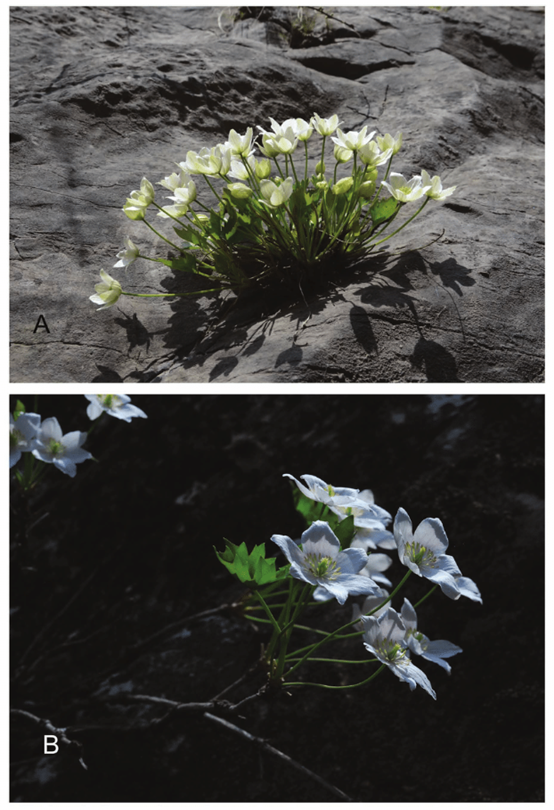Last night, China Biodiversity Conservation and Green Development Foundation (CBCGDF) staff learned from a previous article on the WeChat public account revealed that more than ten strains of relatively thick Clematis acerifolia were cut off. It is reported that Clematis acerifolia is only distributed in Beijing; at the same time, it is suspected that the people who bought these Clematis acerifolia are located in Shanghai. Therefore, the CBCGDF Plant Working Group immediately contacted the public security authorities in Beijing and Shanghai, hoping to resolve it as soon as possible.
Clematis acerifolia (qi ye tie xian lian), a beautiful plant that basically grows only on calcareous rock walls. Shrublets 20--60 cm tall. Branches subterete, not grooved, glabrous; bud scales ovate to ovate-oblong, 4--8 mm, puberulous near apex. Leaves simple, glabrous; petiole 2--5 cm; leaf blade pentagonal, 3--7.5 × 3.5--8 cm, palmately 5-lobed, thick papery, base subcordate to rarely broadly cuneate, margin sparsely dentate, apex acute; basal veins abaxially nearly flat to ± prominent. Flowers 2--4 borne together with leaves from a bud at apex of stem, 3.5--5 cm in diam. Pedicel 5.5--10 cm, glabrous. Sepals 5--8, white or pinkish, spreading, narrowly obovate to oblong, 1.5--2.5 × 0.7--1.5 cm, both surfaces glabrous, apex obtuse, subrounded, or acute. Stamens 5--8 mm, glabrous; anthers narrowly oblong to oblong, 1--2 mm, apex obtuse. Ovaries pubescent. Style ca. 4.5 mm, densely villous. Achenes narrowly ovate, 2.5--3 × 1.2--1.8 mm, densely pubescent; persistent style ca. 2.5 cm, plumose. Fl. Apr--May, fr. May--Jun.
* Rocky cliffs, soil slopes; ca. 200 m. Beijing Shi.
Clematis acerifolia (Clematis acerifolia Maxim.) is an upright small shrub, generally 30 ~ 60 cm high, its living environment is very unique, most of the growth in Beijing, mengtougou limestone mountain cliffs, such as the cliff, therefore, known as "cliff flower" by the local people. Because Clematis acerifolia is distributed in a very narrow area, the population is scarce, and it has unique growth characteristics and habitats. It is very special among wild plants in Beijing and has high ornamental and scientific value. Therefore, it was included in the "Beijing List of Key Protected Wild Plants (Level 1)".
The flowering period of Clematis acerifolia is April, and the fruiting period is May to June. Its flowers are large and beautiful, and the distribution location is unique. It is mainly distributed sporadically on the steep slopes and slopes of low mountains at about 300 meters above sea level. Therefore, it has high ornamental and scientific value and is included in the list of first-class protected plants in Beijing. At the same time, it has a unique living habit-it only grows in limestone mountains, and it must be cliffs, making it more peculiar. The uniqueness and rareness of the Clematis acerifolia make people cherish it very much. Regrettably, with the rising reputation, there have been cases of theft of Clematis acerifolia in recent years, which poses a serious threat to its not lush population. It’s hoped people can take care of Clematis acerifolia and its fragile growth environment So that people can enjoy the spirit of this kind of plant for a long time among the mountains and cliffs.
The problem caused by the scene that has just happened is how did this "Beijing specialty" fly to Shanghai's rich mansion? Who is stealing? Who is selling? Who is the buyer? How long can this endangered rare plant be able to withstand such theft?
Up to now, the CBCGDF Plant Working Group has contacted a number of experts from institutions such as the Institute of Botany, Chinese Academy of Sciences, Peking University, Central University for Nationalities, and IUCN Species Survival Commission (SSC) to understand the situation. Many experts pointed out that the state of plant protection in China is worrying, and many provincial-level protections lists in China have their own names, and they have not really implemented protection.
Some volunteers inferred: This buyer in Shanghai is richer. Based on the environment displayed on social media, is it possible to grow the garden by himself?
After multiple verifications and literature review, on the evening of April 7th, the CBCGDF Plant Working Group has reported the case to the Shanghai Police, and plans to send local volunteers and plant professionals in the next day to accompany the police to investigate the villa area where the suspected thief was revealed on social media.
On the morning of April 8, the CBCGDF Plant Working Group contacted the office of the Mentougou District Landscaping Bureau and the Forest Public Security Office in Beijing. The other party received the evidence submitted by the working group and indicated that it attached great importance to the incident. Clematis acerifolia is said to be only distributed in Mentougou District and Fangshan District in Beijing. The working group then contacted the Fangshan Forest Public Security Office and reflected the situation. The other party stated that it had accepted the case and sought feedback as soon as possible.

Photos of Clematis acerifolia and C. elobata from the field. A: C. elobata from Xiuwu, Yuntai Mountain, Henan Prov. B: C. acerifolia from Liudu, Fangshan County, Beijing.
Taxonomic status of Clematis acerifolia var. elobata, based on molecular evidence - Scientific Figure on ResearchGate. Available from: https://www.researchgate.net/figure/Photos-of-Clematis-acerifolia-and-C-elobata-from-the-field-A-C-elobata-from-Xiuwu_fig1_305519411

Photo source: http://www.efloras.org/florataxon.aspx?flora_id=2&taxon_id=200007578

Suspected a villa location in Shanghai

Pics shown on social media moment
(Photo credit: CBCGDF)
Original reference links:
https://www.gbif.org/species/7277587
http://m.dooland.com/index.php?s=/article/id/847949.html
By / Niu Jingmei, Huang Jin
